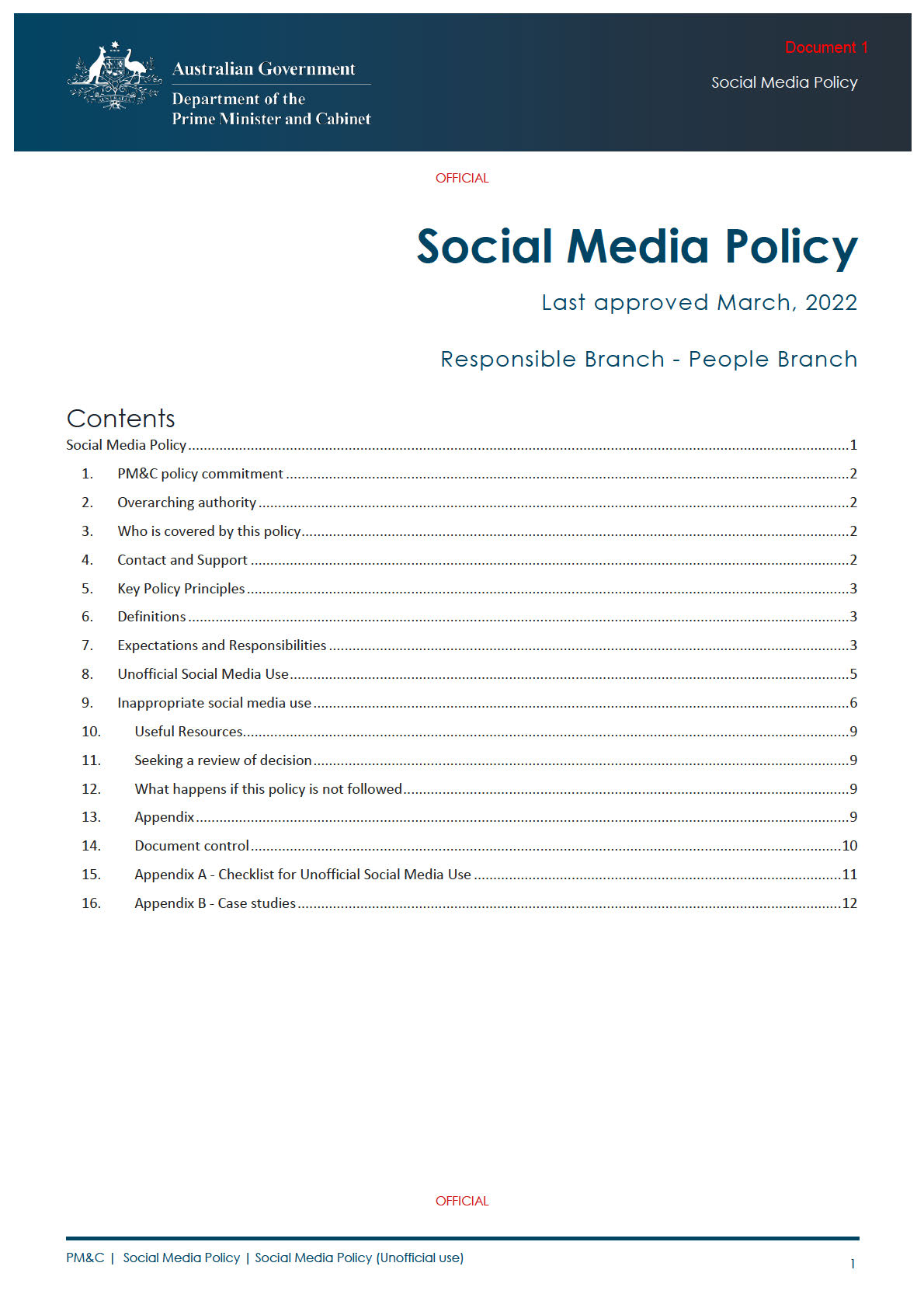
OFFICIAL
1. PM&C policy commitment
Social media is part of everyday life, in both personal and professional contexts. It is a condition of employment that PM&C
employees use social media appropriately; in a manner that upholds the reputation of PM&C, broader public service and is
compliant with the APS Code of Conduct and Values.
This policy is not intended to cover every possible use of social media. This policy provides guidance to PM&C employees on
the use of social media, and outlines their responsibilities when using social media for unofficial purposes. The policy should
be read in conjunction with the Australian Public Service Commission’s Social Media Guidance.
2. Overarching authority
In accordance with Section 13,
Public Service Act 1999 (Cth)
(PS Act)
, al APS employees must behave in a manner consistent
with the APS Values and Code of Conduct.
3. Who is covered by this policy
This policy applies to al PM&C employees, both non-SES and SES.
Individuals engaged as contractors via labour-hire firms and secondees into PM&C, while not formal y covered by this policy,
are expected to act in a manner consistent with the APS Code of Conduct, and conduct standards set out in their contract.
Guidance contained in this policy extends to an employee’s use of social media at al times, including personal and
anonymous use.
PM&C employees who are required to use social media as part of their role, should refer to the Social Media Governance
Policy.
4. Contact and Support
Employees are encouraged to speak with their manager, or manager once removed, for advice in the first instance.
Queries about unofficial social media use (i.e. personal, private use) can be submitted to HR Help through Service Portal or
calling (02) 6271 6000 (option 2). Queries may be escalated by HR Help to the Professional Standards Team.
Queries about official social media use (i.e. operating PM&C social media accounts) can be submitted to the Social Media
Team in Communications Branch by emailing xxxxxxxxxxx@xxx.xxx.xx.
The Australian Public Service Commission Ethics Advisory Service is available to al APS employees, who wish to discuss and
seek advice on ethical issues that occur in the workplace and make sound decisions around these issues. The APSC Ethics
Advisory Service can be contacted on 02 6202 3737 or xxxxxx@xxxx.xxx.xx.
OFFICIAL
PM&C | Social Media Policy
2
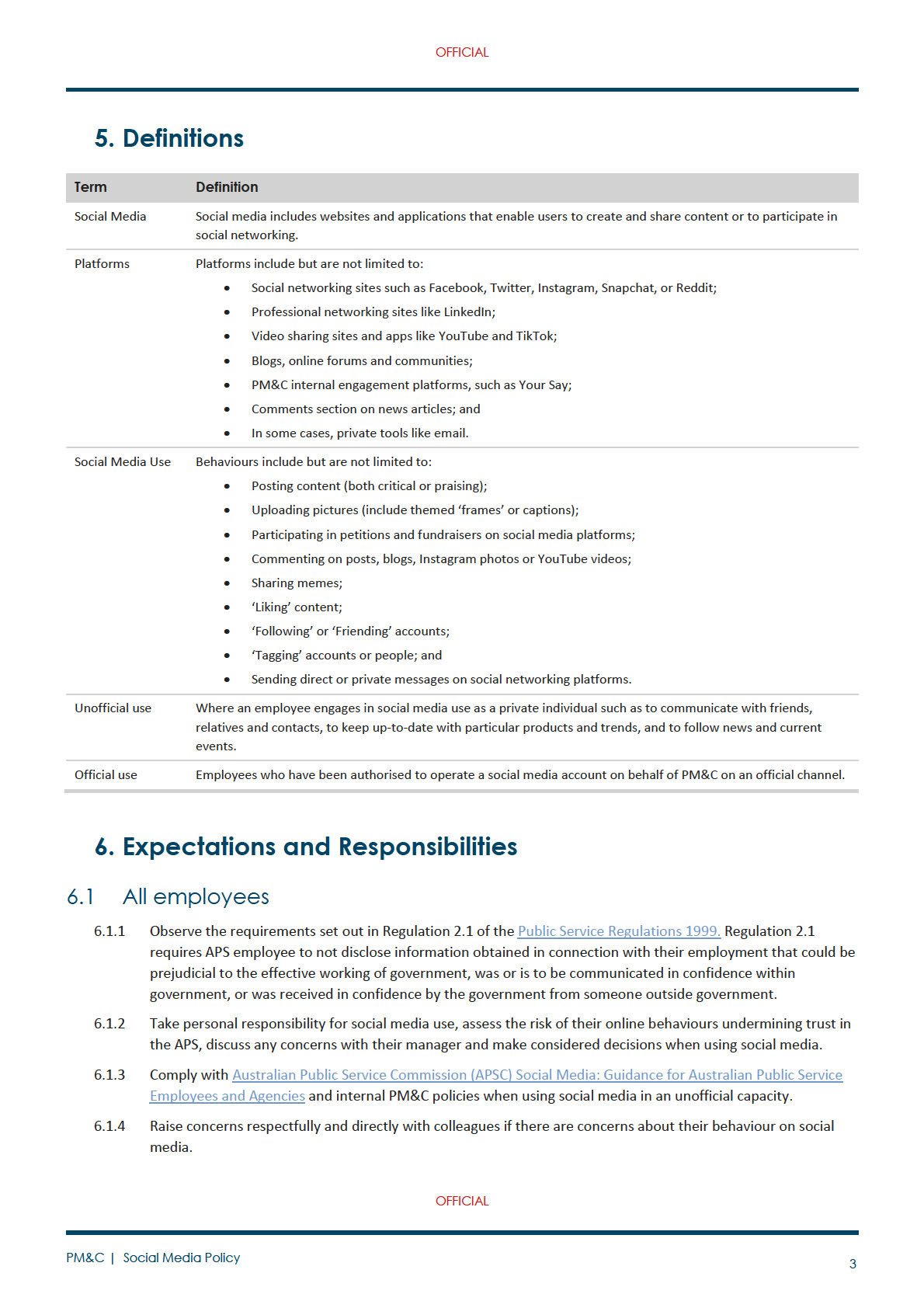
OFFICIAL
6.1.5 Report serious and/or ongoing inappropriate social media use by PM&C employees that may be in breach of
this policy to People Branch.
6.1.6 When necessary, seek guidance and support from People Branch about unofficial social media use.
6.2 Managers
6.2.1 Take reasonable steps to share information with employees to inform their understanding of the current
internal operating environment.
6.2.2 Encourage employees to seek guidance about potential y high risk social media activity before deciding what to
do.
6.2.3 Refer repeated and/or more serious concerns about inappropriate use of social media to People Branch.
6.2.4 Ensure employees are aware of this policy and relevant Australian Public Service Commission (APSC) Social
Media: Guidance for Australian Public Service Employees and Agencies.
6.3 People Branch
6.3.1 Review and maintain this policy to inform managers and employees about their responsibilities related to the
use of social media in an unofficial capacity.
6.3.2 Provide advice, and best practice approaches to employees in relation to unofficial social media use.
6.3.3 Manage reports of inappropriate social media use; and where relevant, take appropriate action in accordance
with PM&C's Procedures for determining breaches of the APS Code of Conduct and the imposition of sanctions.
7. Key Policy Principles
Balancing personal rights and professional obligations
All APS employees are entitled to private lives, personal views, and political opinions. PM&C respects the rights of employees
to participate in political, advocacy, and community activities. In doing so, however, employees must behave in a way that
does not cal into question their capacity to act apolitical y and impartial y in their work. Public confidence in the integrity of
public administration is protected by the APS Values and Code of Conduct.
Employees need to use their judgement when assessing the risks that their online behaviour may pose to public confidence
in PM&C and the APS, so as to strike a reasonable balance between their rights as individuals and their obligations as public
servants.
Assessing the risks, and taking personal responsibility for social media use
The use of social media by government officials can pose a risk to public trust in the APS if it is inappropriate.
The risk of employees’ behaviour reflecting poorly on PM&C, the APS and/or the Government of the day is relative to the
seniority of the individual posting information, the connection between the topic and the individual’s work, and the activity
undertaken online and/or content published (i.e. tone and language).
These risks apply even when content is published anonymously or under an alias or pseudonym.
Al employees must take personal responsibility for their online social media use, and make considered decisions about the
risks of that behaviour reflecting poorly on PM&C and the APS.
OFFICIAL
PM&C | Social Media Policy
4
OFFICIAL
Maintaining awareness of perceived and/or actual positional power and
knowledge
Employment at PM&C conveys a close connection to the Government of the day, and to the decision making processes of
government.
Regardless of an employee’s role in the department, reasonable members of the public may perceive that an employees’
views reflect a:
• deep understanding of government business;
• connection to individual Government Ministers, including the Prime Minister; and/or
• level of power and/or decision making control over government policy and/or programs.
This perception of perceived and/or actual knowledge and power is outside the control of individual employees.
Nonetheless, individual employees must be aware of how their use of social media could be considered by reasonable
members of the public within this context.
Seeking guidance and/or support if in doubt
Employees should seek guidance and/or support from their manager or People Branch if unsure about their unofficial social
media use and/or how to apply this policy.
8. Unofficial Social Media Use
8.1 How personal behaviour can affect confidence in the APS
PM&C has a central role in government administration, including advising the Prime Minister and Cabinet members across a
wide range of policy areas. Members of the community need to have confidence that PM&C employees are serving the
public interest, whilst members of Parliament expect the government of the day to be served impartial y. As such PM&C
employees have a greater responsibility to ensure their social media use is appropriate at al times.
Conduct on social media and comments on some topics by PM&C employees might be given greater weight—and cause
greater concern—than similar comments made by members of the public or employees of other Departments, as they may
be perceived to have privileged access to knowledge and influence within government. This becomes more likely the closer
the topic is to an individual’s area of work, the more senior role the individual’s position is within PM&C, or the more public
the individual’s profile.
This does not mean employees cannot engage online on political or social issues—or that engaging on other issues is always
risk-free. However, when considering whether to comment on such issues, individuals need to be mindful that the closer the
topic is to their work, the Department, or the Prime Minister, the greater the risk it can pose to public confidence in PM&C or
the APS.
8.2 APS behavioural requirements
Al PM&C employees must be aware that professional obligations under the APS Code of Conduct extend into our private
lives, and are balanced with our rights as citizens. In our personal lives we are required to act at al times in a way that
upholds the:
• APS Values and APS Employment Principles; and
• integrity and good reputation of PM&C and the APS (
s 13(11)(a) and (b) of the PS Act).
OFFICIAL
PM&C | Social Media Policy
5
OFFICIAL
Online behaviour committed anonymously, under a pseudonym, or subject to a disclaimer can stil be inappropriate and may
be in breach of the APS Code of Conduct.
Employee’s online behaviours impact on community confidence in employees’ ability to perform their duties impartial y.
Employees should consider their interactions online as akin to interactions in the workplace, and maintain respect and civility
at al times.
8.3 Identifying as a PM&C and/or APS employee
Employees should exercise caution in identifying as a PM&C employee on social media. You must not advertise your security
clearance level online as a requirement of the Australian Government Protective Security Policy Framework (PSPF).
Posting material online which indicates a level of exposure to particular business functions, capabilities or other work-related
information can be a potential security vulnerability for the Department and its employees. Posting this type of content could
potential y impact an employee’s suitability to access Australian Government information and resources. This could result in
being unable to obtain or maintain a Commonwealth security clearance.
When interacting on professional networking platforms such as LinkedIn, where declaration of employment is the norm,
employees should exercise particular caution. Approaches from unknown individuals purporting to want to learn about an
employee and/or their col eagues, the Department, Australian Government policy, business and processes should be
reported to the Department’s Cyber Security team.
8.4 Privacy
Employees are urged not to rely on a platforms’ security settings to assure their privacy. Even material posted in a relatively
secure setting may be copied and reproduced elsewhere, including on platforms that purport to have automatic destruction
or deletion of content after opening or a set time limit.
Employees should also be mindful that content published on social media may become publicly available, even from personal
social media accounts.
Employees are responsible for safeguarding access to their social media accounts by using strong passwords, platform
privacy settings and multi-factor authentication where available. For further information on this topic, please contact the
Department’s Cyber Security team.
9. Inappropriate social media use
9.1 What is inappropriate social media use?
Behaviour on social media is inappropriate when:
• it breaches the APS Code of Conduct;
• it breaches PM&C policies; and/or
• a reasonable member of the community would conclude on the basis of the post or interaction that:
• the employee cannot behave impartial y, professional y, or with integrity in the APS; and/or
• PM&C or the broader APS cannot be trusted to implement the policies of an elected government.
OFFICIAL
PM&C | Social Media Policy
6
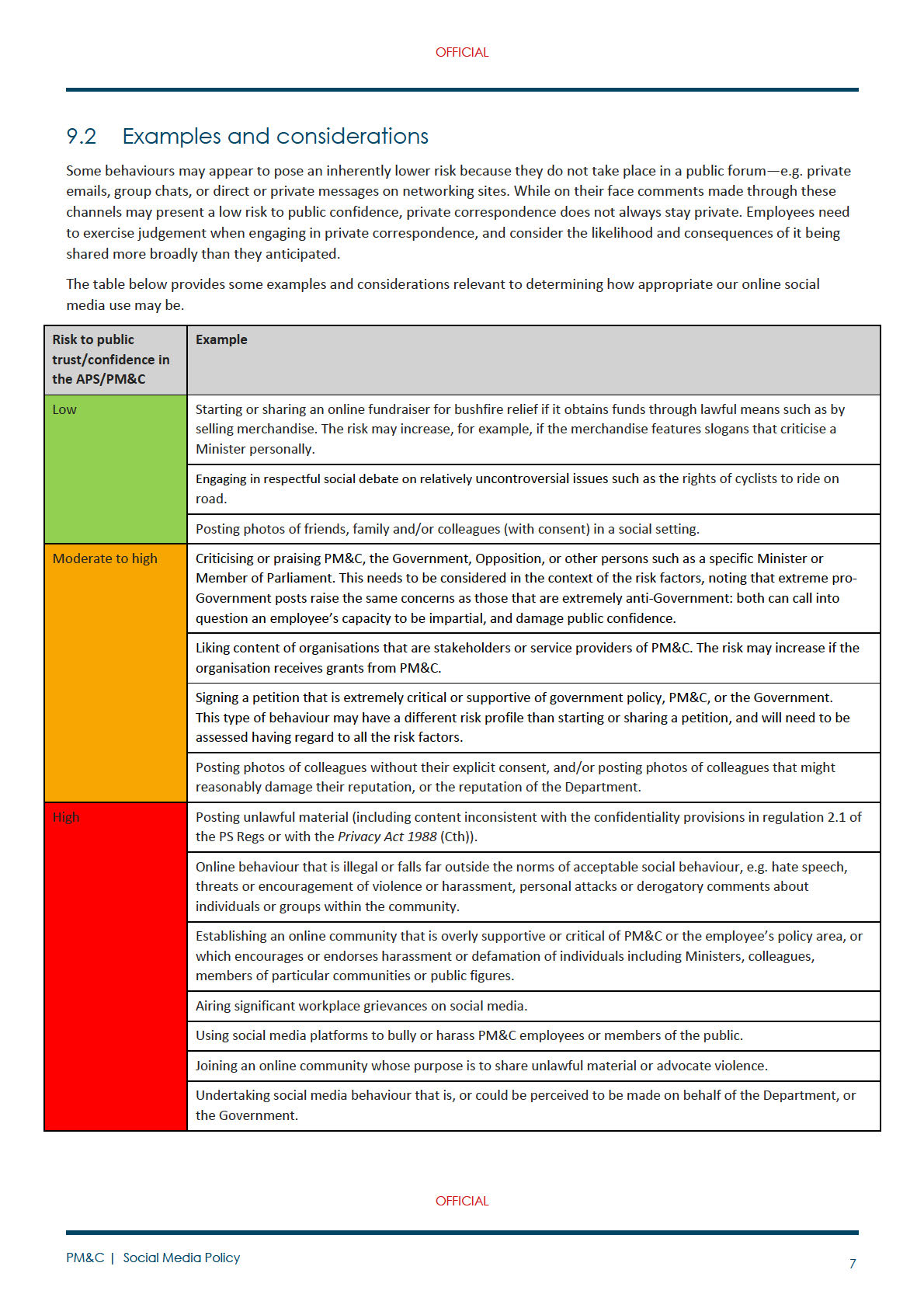
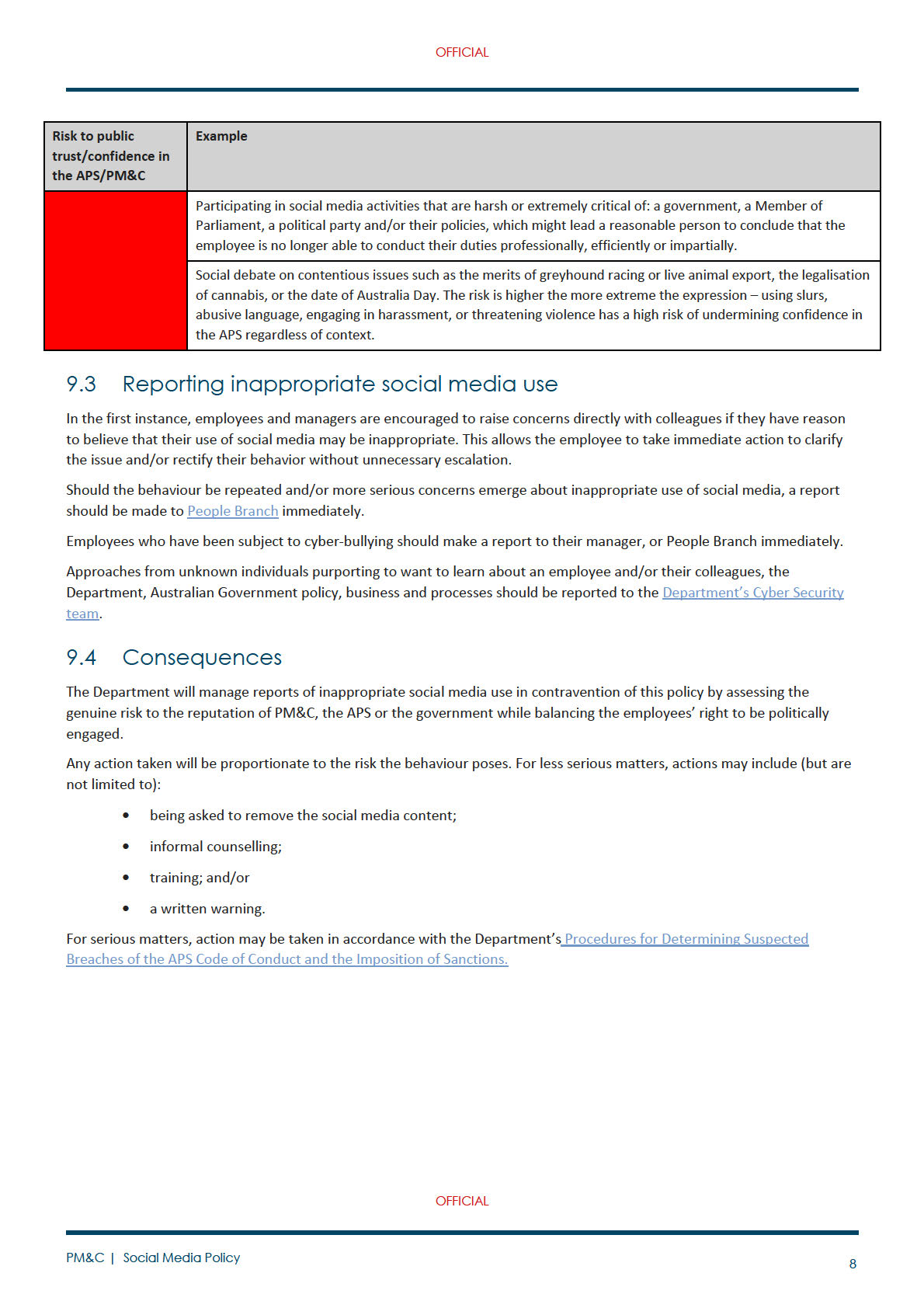
OFFICIAL
10.
Useful Resources
The Australian Public Service Commission (APSC) provides APS employees and agencies with clear guidance about
appropriate unofficial social media use. Employees should familiarise themselves with Australian Public Service Commission
(APSC) Social Media: Guidance for Australian Public Service Employees and Agencies, and:
• Factsheet: Personal Behaviour on Social
• Frequently Asked Questions
Media
• Case Studies
• Social Media: Tips for Employees
A short check list for social media use to assist employees to comply with this policy is at Appendix A.
Other relevant resources:
• Public Service Act 1999 (Cth)
• ICT and Internet Usage Policy
• Public Service Regulations 1999 (Cth)
• APS Values and Code of Conduct in Practice (APSC)
• ICT Security Policy
• Procedures for Determining Suspected Breaches of
• PM&C Online Channel Guidance
the APS Code of Conduct and the Imposition of
• Appropriate Workplace Behaviour Policy
Sanctions
• Conflict of Interest Policy
11.
Seeking a review of decision
PM&C acknowledges the right of employees to raise concerns and make complaints professionally and in good faith, and to
have them received and considered fairly.
Employees are encouraged to raise concerns about decisions relating to their employment with their manager in the first
instance, or with another senior manager. Where concerns cannot be resolved local y, employees can seek assistance from
People Branch in the first instance.
A non-SES employee may seek a formal review of APS actions under section 33 of the Public Service Act 1999. See the Review
of Action Procedures for further information.
12.
What happens if this policy is not followed
If an employee behaves in contravention of this Policy, formal action may be taken in accordance with
PM&C’s Procedures
for Determining Suspected Breaches of the APS Code of Conduct and the Imposition of Sanctions.
13.
Appendix
Appendix A – Checklist for Unofficial Social Media Use
Appendix B – Case Studies
OFFICIAL
PM&C | Social Media Policy
9
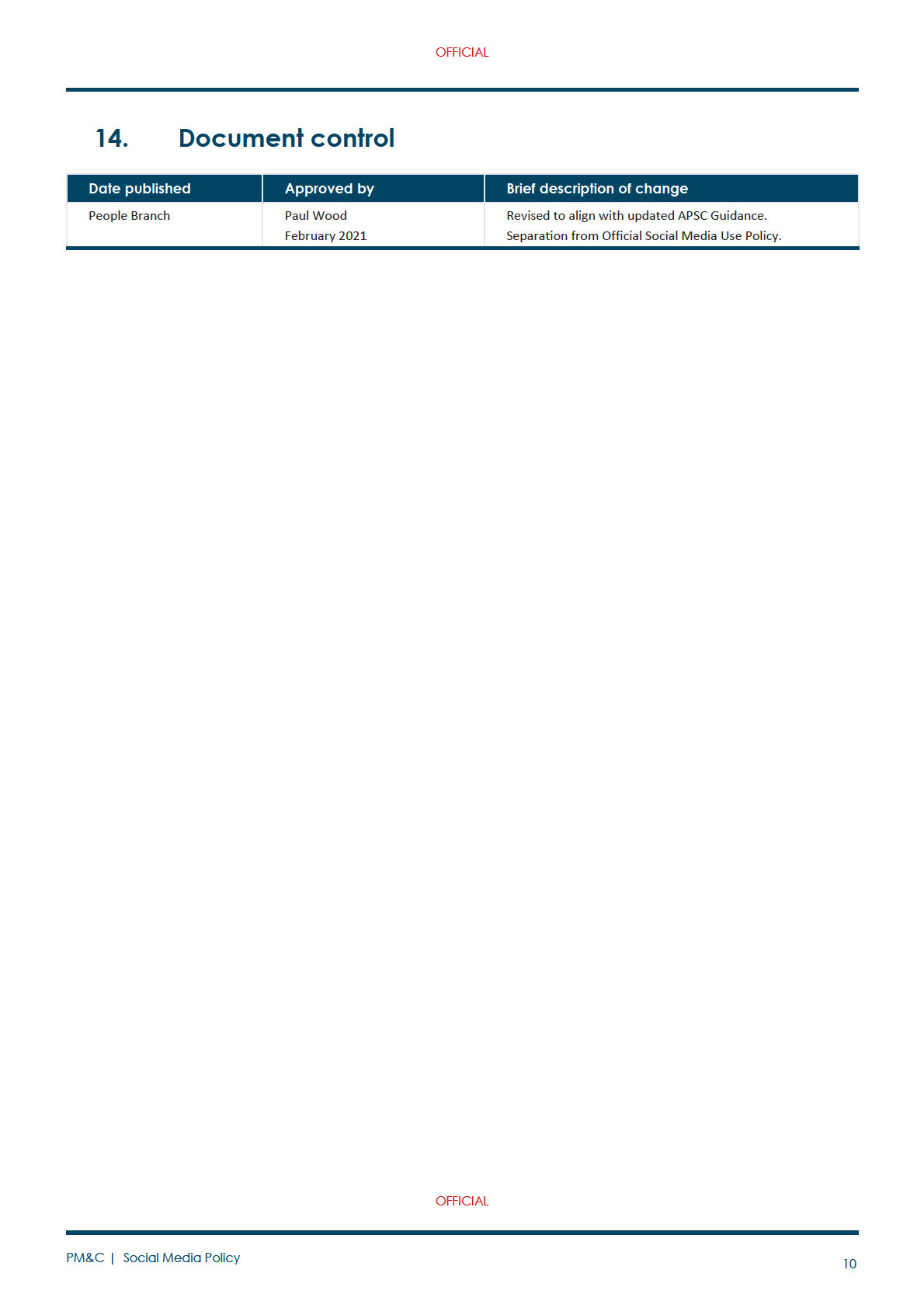
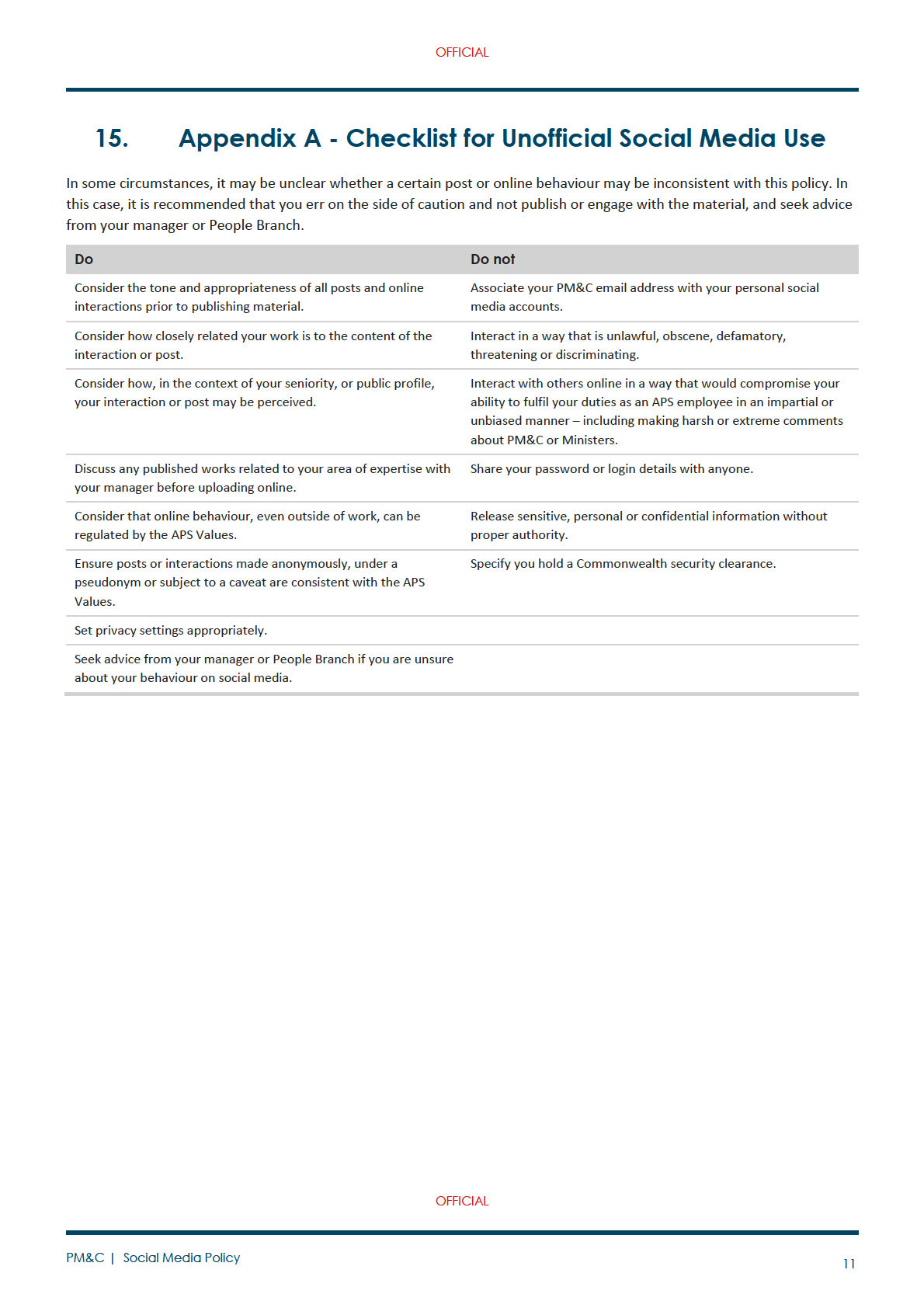
OFFICIAL
16.
Appendix B - Case studies
Scenario 1 – Harry, Corporate Division
Harry is an APS 4 advisor in Corporate Division. Harry’s friend, Donald, posts a meme on Facebook that shows a Minister
with photoshopped devil horns at a press conference. Harry’s friend Lucy then comments on the post and says ‘An
absolute devil, he should be shot! ’ Harry ‘likes’ Lucy’s comment.
Lucy’s comment on Harry’s post is far outside of the social norms, and Harry’s act in ‘liking’ the comment may be seen to
endorse Lucy’s extreme view. This act brings into question Harry’s ability to serve the government impartial y and is
higher risk. Harry needs to be mindful of the unique role that PM&C plays in supporting the Prime Minister and the
government of the day, and how his actions could be perceived.
In the first instance, Harry should avoid engaging with Donald’s meme, and not ‘like’ Lucy’s comment. However, if Harry
engages and later identifies that his actions could undermine the Department or his ability to perform his role impartial y,
best practice would be for Harry to ‘unlike’ Lucy’s comment.
Scenario 2 – Sally, National Bushfire Recovery Agency
Sal y is an EL2 in the National Bushfire Recovery Agency. Sal y posts a link on her personal Twitter account to a press
release from the Example Political Party announcing their revised bushfire recovery plan. The article includes an image of
Sal y with Minister Purple. Sal y captions the post ‘To al my friends and family affected by the recent bushfires, please
educate yourself on the announcement by Minister Purple and let me know if you have any questions in the comments
below.’
As a senior staff member within the Agency, and being pictured with Minister Purple, Sal y would be a strong influence
within the community who would expect that she has insider knowledge about the relevant plan and policies. The
expression in Sal y’s caption is social y acceptable and stimulates conversation. However, depending on the nature of
comments made by her fol owers, the Twitter post is moderately risky. Sal y should take care in moderating any extreme
views, or responding to any questions so as to not represent the response is on behalf of the government, Department or
APS.
Later that night, Sal y reposts an article from the Example News about the Government’s scrapped tax cuts to claw money
back for the budget. Sal y enjoys a glass of wine and is reading the comments on her Twitter post about the bushfire
recovery plan. A comment on the bushfire recovery plan post states the plan fails to support smal business owners.
Frustrated by the comment Sal y responds “
You don’t know the struggles we went through to get here – behind the scenes
the sacrifices made for small business owners like you impacted every other Australian financially. They should be
grateful!”
The expression in Sal y’s response is not vulgar, however it is stil high risk. This is because Sal y has a public profile and it
would be reasonable for members of the public to assume she has access to information that is not publical y circulated
such as budget trade-offs. While Sal y did not state what the ‘financial impact’ was, members of the public may infer it
was the tax cuts as posted by Sal y later that night. Also, Sal y’s language of ‘we’ blurs the line of serving the government
impartial y as it implies she sees herself as part of the government as opposed to impartial y advising or implementing the
governments’ policy.
As a whole, Sal y’s online behaviour is high risk and may impact her ability to serve the government of the day and reduce
the public’s confidence in the APS. Her actions may also be considered serious enough to warrant investigation under the
APS Code of Conduct.
OFFICIAL
PM&C | Social Media Policy
12
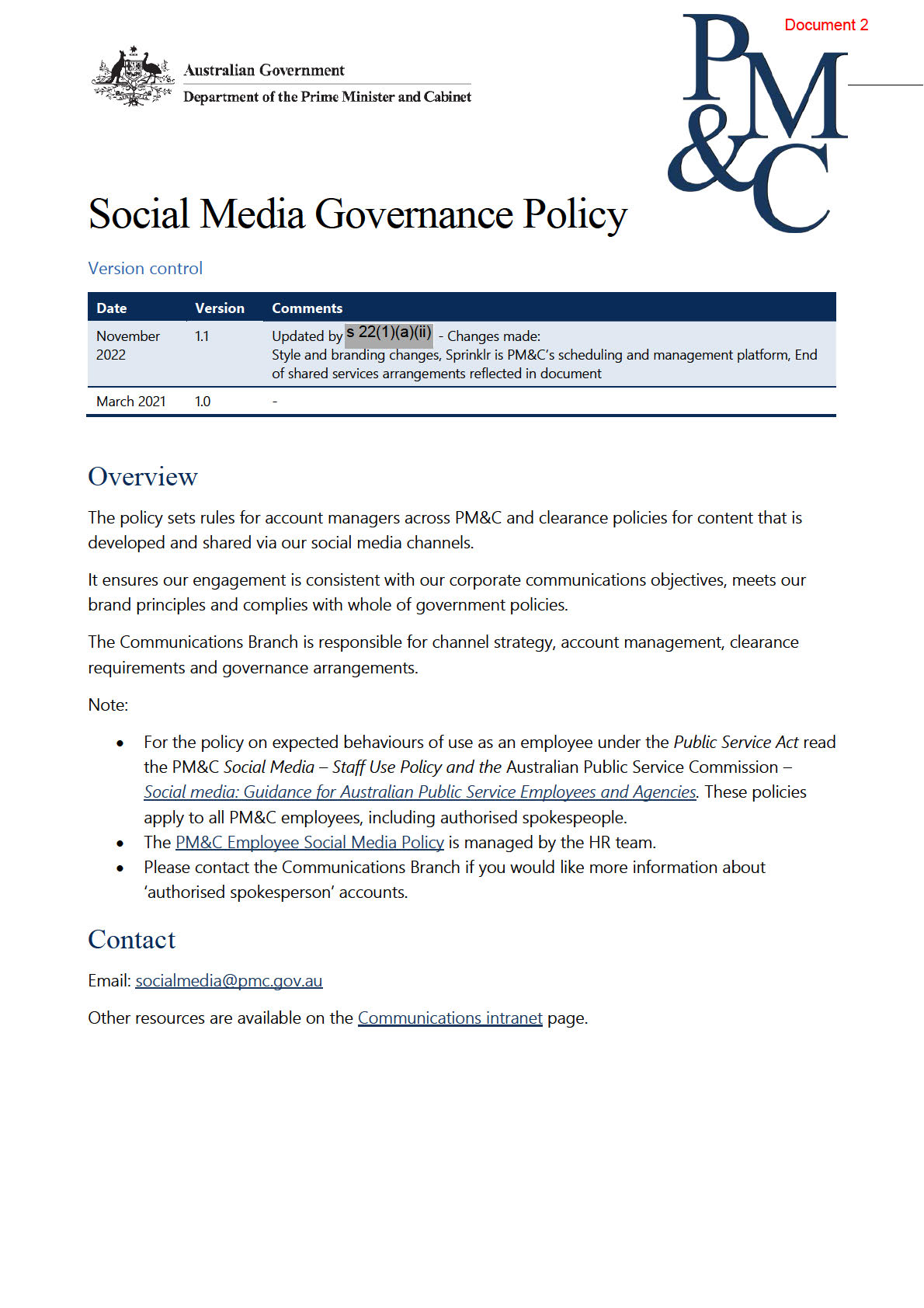
OFFICIAL
Strategic Objectives & Approach
The Department uses social media to share information, engage with stakeholders and to promote
the outcomes of policy and programs.
This policy supports our Digital Communications Strategy, which aims to improve online engagement,
increase transparency, public understanding and community involvement in line with best practice.
Our strategic objectives are to:
1.
Create an integrated PM&C digital ecosystem
Research indicates our audience are interested in more than one policy area. Consolidation of
accounts wil remove the fragmentation of audiences by topic. It also provides the opportunity
to tell deeper stories across policy siloes.
We wil progressively consolidate content from across the remit of PM&C onto PM&C’s social
media channels.
2. Build trust with external audiences.
Content must be current, accurate, and meet a defined user need. It must be written or
designed for the digital environment and in the PM&C tone of voice.
We put our audience first when it comes to content development and channel selection and
we tailor our communications to meet the needs of our audience.
3.
Support PM&C purposes and meet the business needs of PM&C areas/staff
All communications should link to the PM&C core priorities and purposes.
Al content should be planned in agreement with the Communications Branch and prepared
with an ‘audience first’ approach. The Communications Branch wil work with you to get this
right.
If you would like to discuss content for the PM&C or Australia.gov social media channels please
contact the Digital Communications Team at xxxxxxxxxxx@xxx.xxx.xx.
Account Management
The Communications Branch manages the following social media accounts:
• PM&C: Facebook, Twitter, LinkedIn, YouTube, SoundCloud
• Australian Government (AusGov): Facebook, Twitter, LinkedIn, Instagram, YouTube
• National Indigenous Australians Agency: LinkedIn (Ends 9 December 2022)
OFFICIAL
PM&C | Digital Communitcations | Social Media Governance Policy
2
OFFICIAL
• Indigenous.gov: Facebook, Twitter, Instagram, YouTube (Ends 9 December 2022)
• Office for Women: Twitter
In addition the Communications Branch provides advice and governance support to channels
managed by PM&C including:
• Behavioural Economics Team (BETA)
• G20 Australia
• The NDIS Review
• APS Reform
In line with the Department’s work to consolidate channels, new social media accounts and platforms
will only be established in exceptional circumstances in consultation with the Communications Branch
and relevant SES.
Additional accounts may be managed by line areas following consultation with the Communications
Branch and agreed with the relevant Deputy Secretary. Business and content planning, governance
and evaluation methods wil al need to be established and regularly reviewed.
Requests for new social media accounts wil need to complete:
• Request for a new social media account
• Governance for proposed social media accounts
If a new social account has been transferred into the Department with machinery of government
changes – please contact the Digital Communications Team at xxxxxxxxxxx@xxx.xxx.xx to discuss
arrangements for its ongoing use and resourcing. Advice on Decommissioning social media
accounts is outlined below.
PM&C community managers:
In addition to adhering to the Australian Public Service Commission
Social media: Guidance for
Australian Public Service Employees and Agencies, when using social media in an official capacity a
PM&C employee must:
1. be authorised to use social media
2. comply with PM&C's
Social Media Governance Policy and moderation guidance
3. only post approved content where their role requires them to do so. Al content must be
approved at SES Band 1, or above
OFFICIAL
PM&C | Digital Communitcations | Social Media Governance Policy
3
OFFICIAL
4. behave in a way that upholds the integrity and good reputation of PM&C specifical y and the APS
more general y
5. be mindful of the requirements set out in
Regulation 2.1 of the Public Service Regulations 1999
concerning the disclosure of information
6. comply with PM&C's obligations under legislation including the Privacy Act 1988, the Archives Act
1983 and the Copyright Act 1968
7. not make statements that could bring PM&C or the APS into disrepute
8. participate in training and governance sessions arranged by the Communications Branch.
Clearance
Social media is a live and active environment, it is important content is cleared in a timely manner to
ensure the information is current and relevant when it is shared and that al questions are responded
to in a reasonable timeframe.
In line with best practice, al social media content must be in Sprinklr, our content management
system, by 4pm the day prior to its scheduled publication. Any content not in Sprinklr by this time wil
not be published.
There are some exceptions:
• Prime Minister and ministerial media releases and transcripts
• Departmental statements
• Urgent or unforeseen announcements
• Timely retweets / shared posts.
Attachment A outlines clearance requirements for all PM&C social media channels.
Moderation
Al social media accounts need to be regularly monitored to maintain a good relationship with
community, respond to any questions, manage issues and prevent crises.
The PM&C social media moderation guidelines are publicly available on our website.
A response to correct misinformation is the best way to prevent a minor issue escalating into a crisis.
In this instance, we recommend a cleared response is published within two business hours of the
question being received by a Communications branch staff member.
Best practice is that queries not deemed to be offensive or a nuisance are responded to, even if only
an acknowledgement of their question is published. There may be occasions where responding to
OFFICIAL
PM&C | Digital Communitcations | Social Media Governance Policy
4
OFFICIAL
posts is not appropriate, however this should be the exception. Responses to comments should be
drafted, cleared, and posted within two business hours. The expedient posting of replies wil be
prioritised to maintain engaged fol owers and deliver high quality service.
In response to nuisance complaints, the Communications Branch wil determine the appropriate
action to be taken on a case by case basis in line with our moderation guidelines. This may include
hiding, muting, blocking or reporting users, constructively replying to comments or correcting
misinformation.
A file note needs to be maintained of any social media account that has been blocked and the
reason why.
Our public communications receive ongoing attention from the media. Sometimes we are the target
of malicious activity by people seeking to bring disrepute to government. The Communications
Branch maintains relationships with social media providers and can expedite issues resolution when
required.
Handling sensitive material:
If sensitive material is forwarded to a social media account via a comment, reply, direct message or
email please action appropriately.
The PM&C IT Security area are able to assist with assessing the validity of sensitive content, for
example if it is already in the public domain and if it should be escalated.
Email:
s 47E(d)
In case of emergencies contact - s 22(1)(a)(ii) -
s 22(1)(a)(ii)
Ph: s 22(1)(a)(ii)
Reporting
Contact the Australian Federal Police (AFP) directly if the material includes:
• Child exploitation (minors in compromising positions)
• acts of credible violence (terrorist threats, images depicting graphic harm)
• threats of suicide or self-harm (evidence based – specific details mentioned, visual indicators
this may occur).
AFP National Operations State Service Centre (NOSSC) contact information:
• Contact via phone first 02 5127 001
• Email information to xxx.xxxxxxxxxxxxxxxxxxxx@xxx.xxx.xx (during business hours)
• Outside of business hours email: xxx.xxxxx@xxx.xxx.xx or cal 02 5126 0000.
OFFICIAL
PM&C | Digital Communitcations | Social Media Governance Policy
5
OFFICIAL
When you are forwarding content via email:
• take a screen shot or right click and save
• include a message in the email subject message - Warning Disturbing Image
The AFP NOSSC unit are located in Barton, Canberra. If required, they can be contacted to organise a
hand over of sensitive materials.
Record keeping:
Keep a record of incidents by theme. This wil enable you to reporting for resourcing and monitor
changes in metrics.
Evaluation
Al PM&C accounts are monitored and reported on to the Executive on a monthly basis.
Account managers are required to conduct their own analytics and reporting. Templates are supplied
by the Communications Branch and support provided by Sprinklr.
Data should be analysed and evaluated against objectives stated in the communications strategy for
each priority area/account.
Data can be supplied to line areas via detailed written request; however, a minimum of five business
days’ notice is required to prepare the required material.
Security
Account passwords can be shared on a need to know basis only. Passwords must be changed
quarterly and be consistent with the Department’s ICT Security Policy.
To assist issues resolution or urgent requests, up-to-date account details including registered email
addresses, current user list and passwords must be provided to the Digital Communications team
fol owing each password update.
Activate two-factor authentication for social media accounts and associated administration user
profiles.
OFFICIAL
PM&C | Digital Communitcations | Social Media Governance Policy
6
OFFICIAL
Archiving
Social media content authored by the Department is considered a Departmental record and must be
archived.
Decommissioned channels will be archived in accordance with the
Archives Act 1983. Further
information is available from the National Archives Act
Guidelines for managing social media.
Decommissioning
The Communications Branch will work with line areas to ensure their social media presence remains
current and compelling. Any social media channels that have become redundant, or have been
identified by the Communications Branch as being inactive or to have limited participation wil be
decommissioned or repurposed.
Al decommissioning is undertaken by the Communications Branch fol owing a discussion with the
relevant line area and agreement to a closing strategy. The Communications Branch wil :
• assess and mitigate any risks associated with the change
• retain the account name for a period of time to prevent others from assuming the profile’s
identity
• ensure stakeholders and the affected online community are informed of any changes and
have the opportunity to continue their engagement with the topic elsewhere.
Decommissioned channels will be archived in accordance with the
Archives Act 1983. Further
information is available in
Guidelines for managing social media.
Content published on government social media accounts is on the public record. Wherever possible
the accounts should be un-published or made private rather than deleting the accounts.
The implications for un-publishing vs deleting an account are outlined by channel below.
Decommissioning accounts needs to occur in advance
Ensure there is email documentation of the agreement to close the accounts. This should be saved in
the account profile folder of the Social Media.
Advise the Communications Branch AS that the social media accounts wil be closed down.
As soon as there is confirmation to close accounts:
1. update account profile to advise the account wil be no longer be active, for example:
•
On XX XXXX 20XX, our work was completed. This account is no longer active.
OFFICIAL
PM&C | Digital Communitcations | Social Media Governance Policy
7
OFFICIAL
•
This account is no longer active. We are tweeting from @XXXXX – follow our hashtag
#XXXXX
2. Publish and a pin a post that advises the account will be closing down on a particular date.
3. For LinkedIn contact employees linked to the account to advise the page is going to be
rendered not active.
On the date the accounts are closed
1. Publish and pin a post to advise the account is no longer active.
2. Download archival records of published content. Save in the appropriate Share Hub folder.
3. Update account administration records for each Platform to identify who has access or
associated email addresses (e.g. Twitter).
4. Update lists of active social media accounts.
5. Remove account access and related user profiles from social media publishing platforms.
Twitter
• Ensure PM&C Community Mangers have details of the email address (and access codes if
known) used to establish the account and the connected email address and mobile
authentication number are updated and documented.
• Private: Set the Twitter account to private, this wil hide the feed from everyone, except
those that fol ow the page. Fol owers cannot retweet previous posts from the account and
no new content wil appear on the feed.
• De-activate: A Twitter account can be de-activated for 12 months. Content and fol owers
wil stil be there if account is re-activated.
• Delete: Al your content and fol owers wil no longer be deleted. You wil need to reclaim
the Twitter handle so another user does not claim it.
Facebook
• Ensure PM&C Community Managers have admin access to the accounts and that no ad-
accounts linked to the page.
• Un-publish: The content on the Facebook page and fol owers wil remain; the content wil
not be visible to anyone (except page admins) unless the page is republished.
OFFICIAL
PM&C | Digital Communitcations | Social Media Governance Policy
8
OFFICIAL
• Delete page: The page, content and fol owers wil be deleted. Note it can take up to 14
days for the page to be removed.
LinkedIn
• Ensure PM&C Community Managers have administration access to the accounts.
• Not active: the LinkedIn page and content remains public. Users can still follow the
account, and staff can indicate they work at the organisation. A pinned-post wil indicate
the page is not active.
• Delete: a LinkedIn account wil mean al the content has been deleted. A page cannot be
deactivated if there are more than 100 employees.
• Affiliated page: a page can become an affiliated page of the main public page – ensuring
the content is stil available. An affiliated page wil always remain linked to the parent page.
Affiliated pages need to be requested by the main page admins.
Instagram
• Ensure PM&C Community Mangers have details of the email address / connected mobile
authentication number are updated and documented.
• Private: Set the account to private. This means the account posts wil stil be able to be
seen by account fol owers. Comments can stil me left on the posts.
• Temporarily disable: An Instagram account can be temporarily disabled which means the
profile, posts and comments wil al be hidden unless you reactive it.
• Delete: Your Instagram profile, posts and comments wil be permanently removed. You
cannot use the same username or claim the username.
OFFICIAL
PM&C | Digital Communitcations | Social Media Governance Policy
9
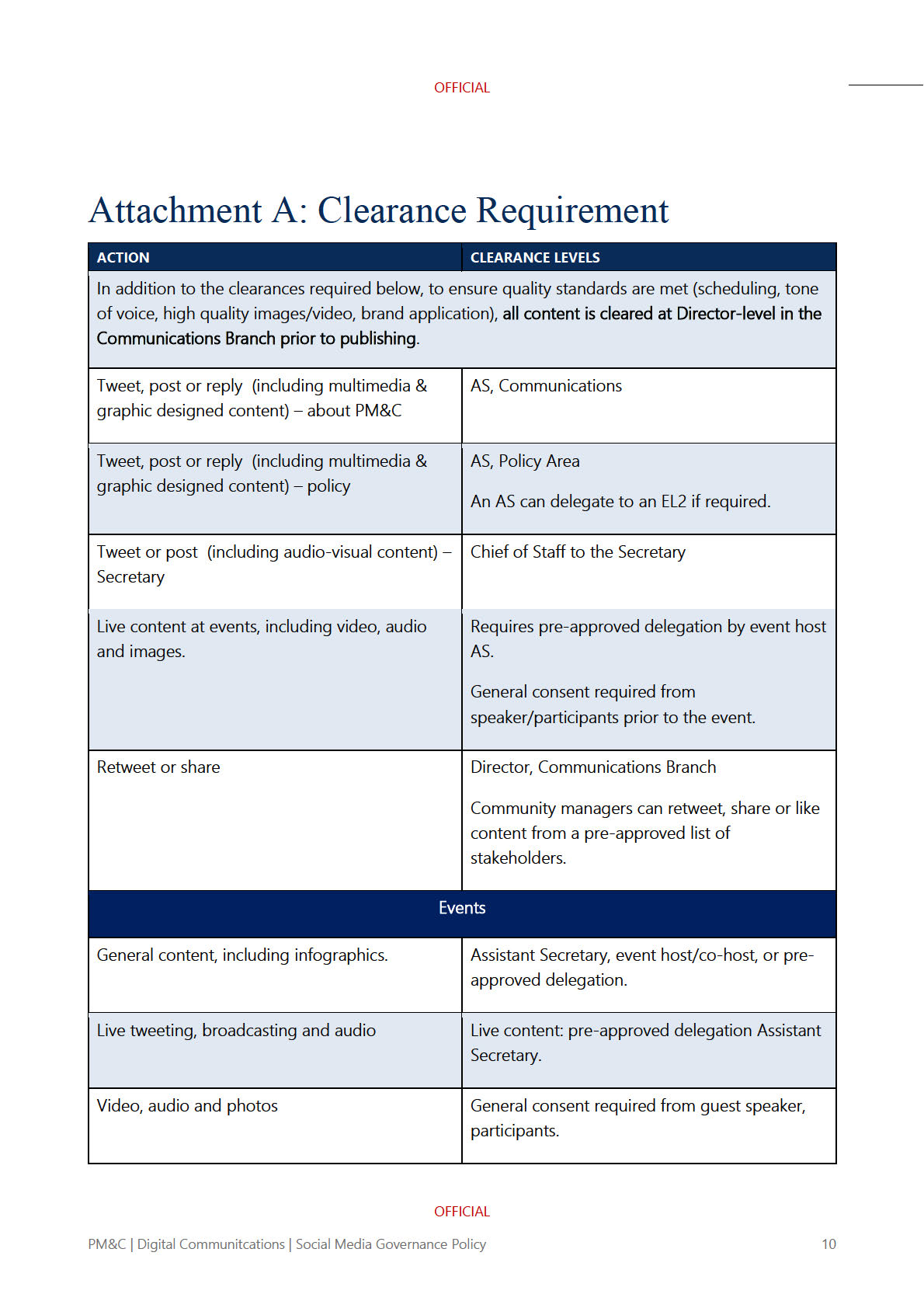
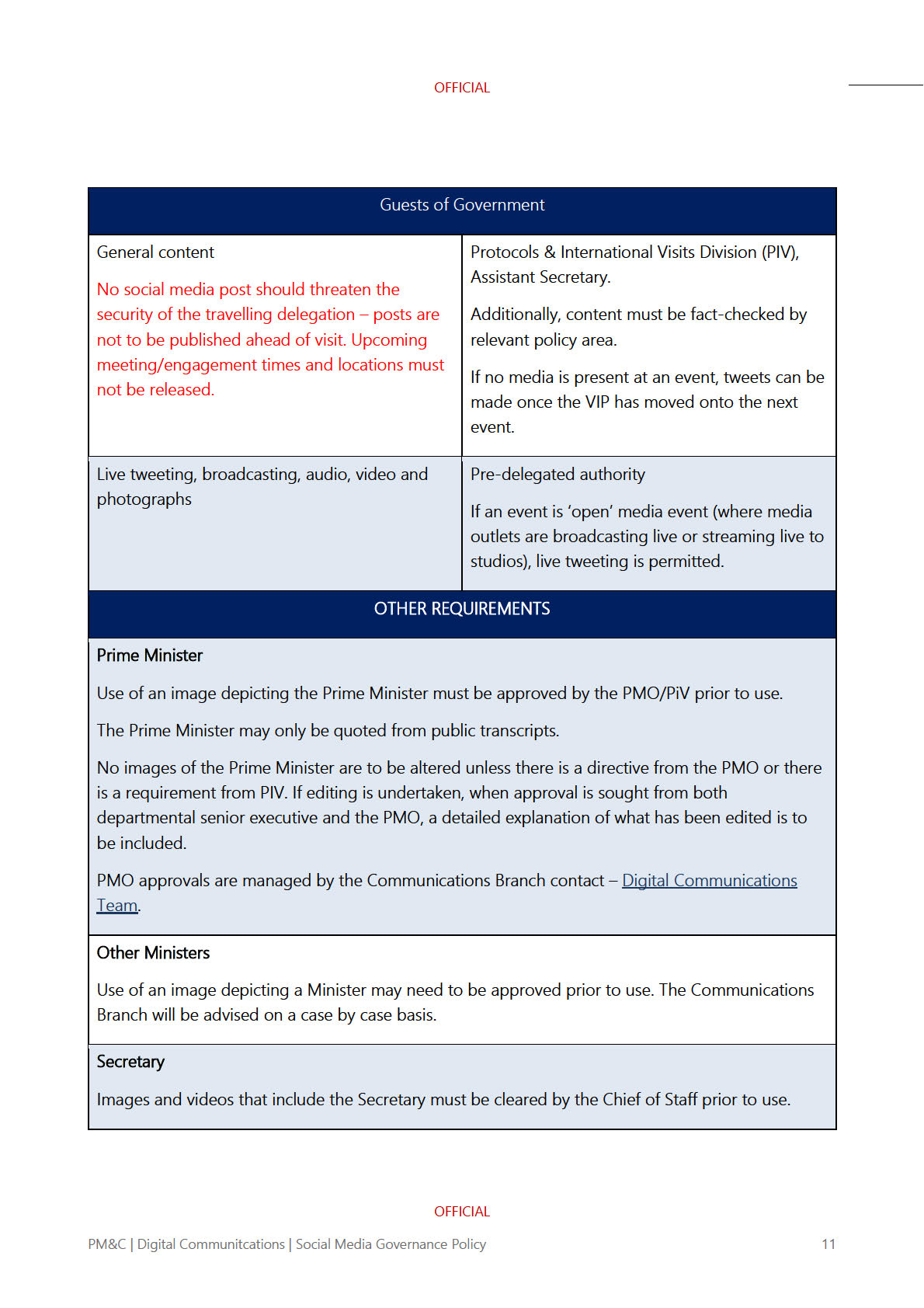
Document 3
Information on the Voice Referendum for employees
This information has been developed to provide employees with guidance on:
• supporting their own wel being leading up to the referendum, as wel as supporting their col eagues
• engaging with the referendum while maintaining the integrity and impartiality of the APS
• safely reporting incidences of racism, discrimination and inappropriate behaviour
• engaging publicly with the referendum either in a personal or of icial capacity
• participating in activities relating to the referendum.
If you are seeking guidance as a manager, please refer to Information on the Voice referendum for managers.
We understand the lead up to the referendum may be difficult for some of our employees who find
commentary and public debate distressing. Heightened exposure to racism and discrimination may put
particular strain on the strength and resilience of our First Nations employees, their families and communities.
Ensuring our workplaces are psychologically and culturally safe is important and the responsibility of us all. The
department is commit ed to a safe workplace that is free from racism, discrimination and inappropriate
behaviour.
It is likely our employees will have a personal view on the issues being discussed, and that they may be asked
about those views and the views of PM&C either at work or outside of the workplace. This page will provide
you with the information to navigate those conversations.
Engaging with the referendum in an official capacity
The role of the Australian Public Service in the referendum
The government is committed to implementing the Uluru Statement from the Heart in ful . This includes
holding a referendum in 2023 to recognise Aboriginal and Torres Strait Islander peoples in the
Constitution, through an Aboriginal and Torres Strait Islander Voice.
The role of the public service in the referendum is the same as in other government policy – to serve
the government of the day and help it deliver on its commitments.
To support the government’s policy agenda, the role of the public service in the referendum involves:
1. Preparing for and delivering the referendum.
2. Providing a trusted source of factual information to the Australian public.
3. Supporting government processes (such as legislation and budget processes) and members of
government (for instance, through briefing and supporting meetings).
The lead up to and during the referendum wil be a unique period in Australian history, presenting some
complexities for public servants to navigate in their day-to-day work. This is particularly true for PM&C
employees who are working directly on the referendum.
PM&C’s role in preparing for and delivering the referendum
PM&C is working with a range of APS agencies to prepare for and deliver the referendum, including
the National Indigenous Australians Agency (NIAA), Attorney-General’s Department (AGD), Department
of Finance and the Australian Electoral Commission (AEC).
As part of our role in assisting the elected government, PM&C wil continue to support government
processes and members of government, including through drafting briefs, speeches and responding to
correspondence from the public.
Talking points when engaging in an official capacity
Some PM&C employees have an important role to play in explaining the government’s policy on the
referendum to stakeholders. Our approach to engaging with stakeholders must support public
confidence in the capacity of the APS to remain impartial.
Employees should explain the government’s policy on the referendum using factual and neutral
language to explain the referendum, rather than advocating for a certain position.
Below are some key points you can use when discussing the referendum with stakeholders or members
of the public.
When describing the government’s policy position:
• The Australian Government is committed to implementing the Uluru Statement from the Heart in
ful .
• The government wil hold a referendum to recognise Aboriginal and Torres Strait Islander peoples
in the Constitution, through an Aboriginal and Torres Strait Islander Voice, in 2023.
• You can go to the Voice website for the most up to date information.
If you are asked about the ‘Yes’ and ‘No’ campaigns:
• The government wil not fund a ‘Yes’ or ‘No’ campaign, but wil develop a neutral, facts-based
civics education program.
• You can go to the Voice website for the most up to date information.
If you are asked about voter enrolment:
• It is compulsory by law for al eligible Australian citizens aged 18 and older to enrol and vote in
referendums. This wil work in the same way as a federal election.
• If you are already enrol ed, you do not need to enrol again to vote in the referendum.
• For more information or to check your enrolment status, visit the Australian Electoral Commission.
If you are asked to provide a personal opinion:
• The public service’s role in the referendum is to provide a trusted source of factual information
and to remain impartial. I’m sorry, but it is not appropriate that I share my own views when I’m
working.
Inappropriate comments in an official capacity include:
• Presenting arguments for or against the Voice.
• Attempting to persuade stakeholders to vote ‘Yes’ or ‘No’ in the referendum.
Engaging with the referendum in a personal capacity
The Australian Public Service Commission (APSC) has developed guidance for employees who wish to
engage publicly with the referendum in a personal capacity. This may include situations such as:
• attending a community event
• making comments on social media
• volunteering time or donating money to a campaign
• discussing the referendum with family and friends.
Employees are encouraged to fol ow the guidance available on the APSC website.
Supporting your wel being
PM&C recognises that engaging with the referendum – whether in a personal or official capacity – can
be a chal enging responsibility to navigate. As public commentary about the referendum intensifies, you
may come across views or opinions that you find uncomfortable or distressing. In the first instance, please
speak with your manager. The Wel being team can provide additional confidential support to anyone who
does not want to disclose concerns to their manager, or who may require support such as reasonable
adjustments to be put in place.
You can access a range of support services such as the Employee Assistance Program (EAP) (1300 360 364) for
you and your immediate family. First Nations employees can access free and confidential counselling and
support through a dedicated Aboriginal and Torres Strait Islander Support line (1800 816 152).
For immediate and urgent 24/7 support, contact:
• 13YARN (13 92 76) (First Nations employees)
• Lifeline (13 11 14).
PM&C’s Mara Network fosters opportunities for Aboriginal and Torres Strait Islander employees to support each
other, as well as share information and lived experiences.
A range of additional mental health and wellbeing support options are available to assist you in the lead up and
during the referendum.
Supporting your colleagues
It’s likely we will al have dif erent reactions and experiences in relation to the issues being raised about the
Voice and we need to be considerate of our col eagues. For example, staff with lived experience relevant
to the referendum may have a different experience of the debate, and it is important not to make
assumptions about experience or wil ingness to engage.
Before engaging with col eagues about the Voice and referendum:
• Take active steps to inform yourself. The Aboriginal and Torres Strait Islander Voice website has the
most up-to-date information and resources.
• Practice judgement and be mindful of who may hear your conversation and the impact the
conversation may have.
• Respect the rights of others not to engage in conversation about referendum.
• Behave respectful y and with courtesy at al times, and raise inappropriate behaviour with a trusted
manager or the People Branch.
The Cultural Protocols Guide eBook provides information and guidance on working respectfully and
ef ectively with Aboriginal and Torres Strait Islander peoples and communities and is a useful resource for
employees around behaviour, communication and cultural protocols.
Training courses have been scheduled on the Corporate Training Calendar to support employees, including:
• Pindara Cultural Training
• Managing Mental Health
Talking points when engaging with colleagues
Here are tips and key messages you can use to help engage with colleagues about the referendum.
If you’re comfortable responding to questions
• There wil be a referendum proposing to recognise Aboriginal and Torres Strait Islander people in
the Constitution through establishing an Aboriginal and Torres Strait Islander Voice. The referendum
wil happen in late 2023.
• It’s important you are ful y informed and conduct your own research.
• The Aboriginal and Torres Strait Islander Voice website has up-to-date information about the Voice.
You can subscribe to receive the latest information.
• Other relevant sources of information include:
o Australian Electoral Commission website
o Parliamentary Education Office website
If you don’t want to answer questions or engage in conversation
• Thank you for asking for my opinion, but I’d prefer not to discuss this. I recommend you check
the fol owing resources to help with your understanding:
o The Aboriginal and Torres Strait Islander Voice website has up to date information about
the referendum. You can subscribe to the monthly newsletter.
o Other relevant sources of information include:
Australian Electoral Commission website
Parliamentary Education Office website
Fulfilling cultural obligations for First Nations employees
Some First Nations employees may have cultural obligations leading up to and during the referendum.
With delegate approval, First Nations employees required to return to their community to conduct or
participate in business such as Lore Business relating to the referendum can:
• access up to three days of Cultural and Ceremonial Leave with pay
• access up to two months of leave without pay
• negotiate flexible working arrangements during that period.
For further information on leave provisions, refer to the PM&C Leave Policy and Flexible Work Policy.
Reporting inappropriate behaviour experienced at work
PM&C is committed to promoting and maintaining a culture of courtesy and respect in the workplace.
It is important staff are mindful of discussions and comments about the Voice and referendum.
Al employees, contractors and consultants should be able to work in a safe, positive and supportive
environment that is free from inappropriate workplace behaviour. This behaviour includes, but is not
limited to, discrimination, racism, harassment, bul ying and interpersonal conflict.
More information is available in PM&C’s Appropriate Workplace Behaviour Policy, including a
conversation guide for addressing inappropriate behaviour and options for reporting complaints.
Complaints may be managed confidentially and sensitively.
Reporting inappropriate behaviour experienced outside of work
eSafety Commissioner
The eSafety Commissioner has resources to help you if you experience online abuse or cyberbullying.
Visit the eSafety website for information, resources, or to report serious online abuse.
Threatening behaviour
If you experience threatening behaviours outside of work, you should contact your local police or dial
000 in an emergency.
If you come across misinformation online outside of work, you are under no obligation to report or correct it.
While it may be dif icult to step back in these situations, in most cases, it is best to not engage with misinformation.
This is because arguing with someone online makes it more likely that a larger number of people will see the
original post.
If the misinformation is being spread by someone who is close to you, you might direct them to the Voice website
or the Australian Electoral Commission. Both have factual and up-to-date information about referendums and
the Voice proposal.
Sidebar links
Website links
• Aboriginal and Torres Strait Islander Voice
• Australian Electoral Commission
• Australian Public Service Commission (APSC)
• APSC Ethics Advisory Service
• The Statement - Uluru Statement from the Heart
Document links
• APS Code of Conduct
• APSC Values and Code of Conduct in Practice-Section 6 - Employees as Citizens
• APSC Engagement in the Voice Referendum in a personal capacity
• APSC’s Case Study on APS Employee use of Social Media
• Joint Letter to Secretaries and Agency Heads on the Referendum
• PM&C Appropriate Workplace Behaviour Policy
• PM&C Conflict of Interest Policy
• PM&C Procedures for Determining Breaches of the APS Code of Conduct and the Imposition
of Sanctions
• PM&C Social Media Policy
•
Public Service Act 1999
• Social media: APS Guidance for Australian Public Service Employees and Agencies








